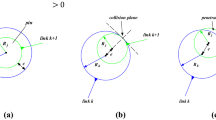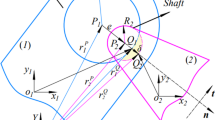Abstract
Clearances are necessary in assemblage of mechanisms to allow the relative motion between the members. This clearance is due to machining tolerances, wear, material deformations, and imperfections, and it can worsen mechanism performance such as precision and vibration. As a new study in this topic, the effect of joint stiffness on the variation of instantaneous natural frequencies and mode shapes of a flexible four-bar mechanism with a clearance between coupler and follower is studied in this paper. To model the clearance, the continuous contact approach is used. The Lankarani’s and Nikravesh’s continuous contact force model is used to model the contact force arising from contact between journal and bearing. Finite element method is used to determine the instantaneous natural frequencies and their corresponding mode shapes. The stiffness of the clearance is modeled as a linear spring added to the assembled stiffness matrix. To validate the clearance model in rigid mechanism, the dynamic response is compared with the results in the literature. To show the validity of the formulation which calculates the instantaneous natural frequencies, two methods are used and compared with each other in the case no clearance exists. The results show that taking the joint stiffness into account has a considerable effect on the instantaneous natural frequencies and their corresponding mode shapes of a flexible multibody system.



















Similar content being viewed by others
References
Wu CLS, Earles SWE (1977) A determination of contact-loss at a bearing of a linkage mechanism. J Eng Ind 99(2):375–380
Haines RS (1980) A theory of contact loss at resolute joints with clearance. J Mech Eng Sci 22(3):129–136
Earles SWE, Seneviratne LD (1990) Design guidelines for predicting contact loss in revolute joints of planar mechanisms. Proc Inst Mech Eng Part C 204(1):9–18
Erkaya S, Uzmay I (2008) A neural-genetic (NN-GA) approach for optimizing mechanisms having joints with clearance. Multibody Syst Dyn 20:69–83
Erkaya S, Uzmay I (2009) Optimization of transmission angle for slider–crank mechanism with joint clearances. Struct Multidisc Optim 37:493–508
Sardashti A, Daniali HM, Varedi SM (2013) Optimal free-defect synthesis of four-bar linkage with joint clearance using PSO algorithm. Meccanica 48:1681–1693
Dubowsky S, Freudenstein F (1971) Dynamic analysis of mechanical systems with clearances, Part 1: formulation of dynamic model. J Eng Ind 93(1):305–309
Dubowsky S, Freudenstein F (1971) Dynamic analysis of mechanical systems with clearances, part 2: dynamic response. J Eng Ind 93(1):310–316
Seneviratne LD, Earles SWE, Fenner DN (1990) Analysis of a four-bar mechanism with a radially compliant clearance joint. Proc Inst Mech Eng Part C 210(3):215–223
Ravn P (1998) A continuous analysis method for planar multibody systems with joint clearance. Multibody Syst Dyn 2:1–24
Schwab AL, Meijaard JP, Meijers P (2002) A comparison of revolute joint clearance models in the dynamic analysis of rigid and elastic mechanical systems. Mech Mach Theory 37:895–913
Flores P, Ambrosio J (2004) Revolute joints with clearance in multibody systems. Comput Struct 82:1359–1369
Feng BZ, Yang Z (2013) A hybrid contact force model of revolute joint with clearance for planar mechanical systems. Int J Non-Linear Mech 48:15–36
Rahmanian S, Ghazavi MR (2015) Bifurcation in planar slider–crank mechanism with revolute clearance joint. Mech Mach Theory 91:86–101
Salahshoor E, Ebrahimi S, Maasoomi M (2016) Nonlinear vibration analysis of mechanical systems with multiple joint clearances using the method of multiple scales. Mech Mach Theory 105:495–509
Ebrahimi S, Eberhard P (2005) Contact of planar deformable bodies using a linear complementarity formulation. PAMM Proc Appl Math Mech 5(1):197–198
Ebrahimi S, Hippmann G, Eberhard P (2005) Extension of the polygonal contact model for flexible multibody systems. Int J Appl Math Mech 1:33–50
Ebrahimi S, Eberhard P (2006) A linear complementarity formulation on position level for frictionless impact of planar deformable bodies. J Appl Math Mech 86:807–817
Ebrahimi S (2007) A contribution to computational contact procedures in flexible multibody systems. Dissertation, Reihe: Schriften aus dem Institut für Technische und Numerische Mechanik der Universität Stuttgart, Band 8, Shaker Verlag, Germany
Dubowsky S, Freudenstein F (1971) Dynamic analysis of mechanical systems with clearances, part I: formation of dynamic model. J Eng Ind 93:305–309
Rhee JK, Akay A (1996) Dynamic response of a revolute joint with clearance. Mech Mach Theory 31:121–134
Flores P, Ambrosio J, Claro JP, Lankarani HM (2007) Dynamic behaviour of planar rigid multi-body systems including revolute joints with clearance. Proc Inst Mech Eng Part K J Multi-body Dyn 221(2):161–174
Khemili I, Romdhane L (2008) Dynamic analysis of a flexible slider–crank mechanism with clearance. Eur J Mech A/Solids 27:882–898
Mukras S, Kim NH, Mauntler NA, Schmitz TL, Sawyer WG (2010) Analysis of planar multibody systems with revolute joint wear. Wear 268:643–652
Feng BZ, Yang Z, Gui WX (2013) Wear analysis of revolute joints with clearance in multibody systems. Phys Mech Astron 56:1581–1590
Zhao B, Zhang ZN, Dai XD (2013) Prediction of wear at revolute clearance joints in flexible mechanical systems. Procedia Eng 68:661–667
Pei L, Wei C, Bin ZA (2013) An improved practical model for wear prediction of revolute clearance joints in crank slider mechanisms. Sci China Technol Sci 56(2):2953–2963
Zhang X, Zhang X, Chen Z (2014) Dynamic analysis of a 3-RRR parallel mechanism with multiple clearance joints. Mech Mach Theory 78:105–115
Zhang Z, Xu L, Tay YY, Flores P, Lankarani H (2015) Multi-objective optimization of mechanisms with clearances in revolute joints. Mech Mach Sci 24:423–433
Varedi SM, Daniali HM, Dardel M, Fathi A (2015) Optimal dynamic design of a planar slider-crank mechanism with a joint clearance. Mech Mach Theory 86:191–200
Chunmei J, Yang Q, Ling F, Ling Z (2002) The non-linear dynamic behavior of an elastic linkage mechanism with clearances. J Sound Vib 249(2):213–226
Flores, P. (2004) Dynamic analysis of mechanical systems with imperfect kinematic joints. Ph.D. Dissertation, University of Minho, Braga, Portugal
Flores P, Ambrosio J, Claro JP (2004) Dynamic analysis for planar multibody mechanical systems with lubricated joints. Multibody Syst Dyn 12:47–74
Ebrahimi S, Salahshoor E, Maasoomi M (2017) Application of the method of multiple scales for nonlinear vibration analysis of mechanical systems with dry and lubricated clearance joints. J Theor Appl Vib Acoust 3(1):42–61
Vaidya AM, Padole PM (2010) A performance evaluation of four bar mechanism considering flexibility of links and joints stiffness. Open Mech Eng J 4:16–28
Zhao Y, Zhang B, An G, Liu Z, Cai L (2016) A hybrid method for dynamic stiffness identification of bearing joint of high speed spindles. Struct Eng Mech 57(1):141–159
Erkaya S (2012) Prediction of vibration characteristics of a planar mechanism having imperfect joints using neural network. J Mech Sci Technol 26:1419–1430
Yang G, Yang J, Qiang C, Ge J, Chen Q (2012) Natural frequencies of a cantilever beam and block system with clearance while block staying on given position. J Vib Control 19:262–275
Winfrey RC (1971) Elastic link mechanism dynamics, Transaction of the ASME. J Eng Ind 93(1): 268–272
Turcic DA, Midha A (1984) Dynamic analysis of elastic mechanism systems. Part I: applications. J Dyn Syst Meas Control 106:249–254
Aannaque A (1996) Kineto-elastodynamic analysis of high-speed four-bar mechanism. Ph.D. dissertation, University of Aston, Birmingham, England
Zhao C, Tang W, Meng M (2008) Effects of gyroscopic effects on natural frequencies and modes of Nipper Mechanism on a Comber. International conference on experimental mechanics
El Madany M, Alata M (2014) Optimal control of reduced order finite element models of rotor bearing support systems. J Braz Soc Mech Sci Eng 37:1485–1497
Hedayati R, Jahanbakhshi M (2015) Finite element analysis of an aluminum airplane stabilizer against birdstrike. J Braz Soc Mech Sci Eng 38:317–326
Schiara LS, Ribeiro GO (2015) Finite element mesh generation for fracture mechanics in 3D coupled with ansys: elliptical cracks and lack of fusion in nozzle welds. J Braz Soc Mech Sci Eng 38:253–263
Kitis L, Lindenberg RK (1990) Natural frequencies and mode shapes of flexible mechanisms by a transfer matrix method. Finite Elem Anal Des 6:267–285
Lankarani HM, Nikravesh PE (1990) A contact force model with hysteresis damping for impact analysis of multi body systems. ASME J Mech Des 112:369–375
Ambrósio JAC (2003) Impact of rigid and flexible multibody systems: deformation description and contact models. Virtual Nonlinear Multibody Syst 103:57–81
Flores P, Ambrosio J (2010) On the contact detection for contact-impact analysis in multibody systems. Multibody Syst Dyn 24(1):103–122
Yu SD, Xi F (2003) Free vibration analysis of planar flexible mechanisms. Trans ASME 125:764–772
Author information
Authors and Affiliations
Corresponding author
Additional information
Technical Editor: Kátia Lucchesi Cavalca Dedini.
Rights and permissions
About this article
Cite this article
Ebrahimi, S., Salahshoor, E. & Moradi, S. Vibration performance evaluation of planar flexible multibody systems with joint clearance. J Braz. Soc. Mech. Sci. Eng. 39, 4895–4909 (2017). https://doi.org/10.1007/s40430-017-0855-0
Received:
Accepted:
Published:
Issue Date:
DOI: https://doi.org/10.1007/s40430-017-0855-0




